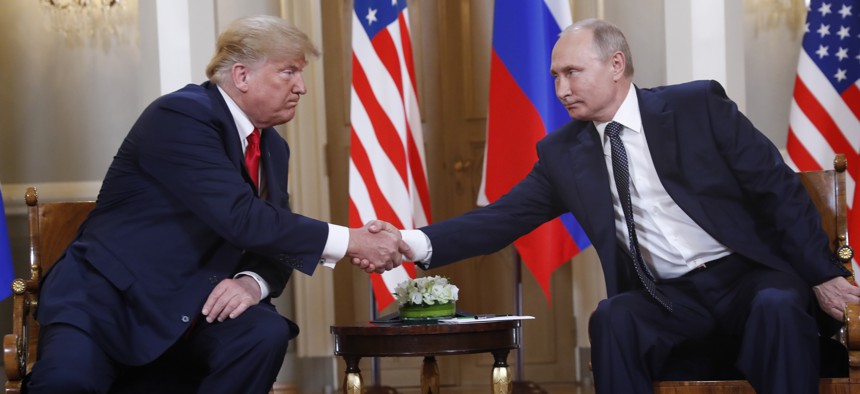
U.S. President Donald Trump, left, and Russian President Vladimir Putin shake hand at the beginning of a meeting at the Presidential Palace in Helsinki, Finland, Monday, July 16, 2018. AP Photo/Pablo Martinez Monsivais
Trump Meets Putin While America Confronts Russia
The U.S. president may be seeking better terms with his counterpart. But the relationship between their countries just seems to keep getting worse.
Donald Trump’s scolding of NATO allies, his digs at Britain’s prime minister and dismissal of investigations into Russian interference in the 2016 U.S. election as a “rigged witch hunt” even though he knew Russian intelligence officers were about to be indicted back home for messing with American democracy—all right before meeting with Vladimir Putin in Finland—have revived a long-running narrative: The president of the United States, wittingly or unwittingly, is doing Russia’s bidding.
“I’m not ready to say that our president is a Russian agent, but I have an agent, and he doesn’t do as much for me as Trump does for Russia,” the comedian Stephen Colbert joked. A more serious argument goes that Trump is undermining not just NATO but the whole post-World War II “Western order: our security relationships, our trade relationships, our special friendships with the U.K., Canada, Germany, and institutions like [the] EU, WTO, [and] UN,” as the New York Times columnist Nicholas Kristof wrote. “This is Putin’s dream.”
But if this is Putin’s dream, is it more of a nightmare? Whatever Trump’s intentions, U.S.-Russia relations are arguably at their lowest point since the end of the Cold War. And many of Trump’s policies have intensified the confrontation. In Brussels this past week, for example, Trump did indeed place heavy strain on NATO, whose main mission is to deter and defend against Russia, by threatening that the United States will “go its own way” if the military alliance’s members don’t spend more on defense. But then those members reaffirmed their commitments to do just that while also continuing to encourage Russia’s neighbors Georgia and Ukraine to join NATO. The result of all the drama of the NATO summit, in other words, was at least in monetary terms a more-powerful military bloc that could soon extend its reach further along Russia’s borders—precisely what Putin has identified as “a direct threat to Russian security.”
As Trump, who is engaged in his own nuclear-arms race with Putin, observedregarding the additional funds pledged by NATO members, “I don’t think that’s helping Russia.” In Brussels, Trump also laced into Germany for buyingbillions of dollars worth of gas from Russia and thus leaving itself vulnerable to Putin, while in Trump’s view not contributing sufficient military resources to NATO. Again, not exactly helpful to Russia.
Yes, Trump has said and done all sorts of things that please Putin. He has refused to take seriously his own government’s findings about Russian meddling in America’s democratic process, though it’s impossible to separate this policy issue from the political reality that the probe into Russia’s actions casts a dark shadow on his presidential campaign and his very legitimacy as a leader. (In Britain on Friday, Trump promised to ask Putin yet again what he was up to in 2016, as if getting to the bottom of the most brazen foreign intervention in U.S. politics in recent memory was simply a matter of asking the Russian leader enough times whether he did it.) He has repeatedly praised the “strong” rule of Russia’s repressive leader, nearly never saying a bad word about him while taunting almost everyone else, and recently congratulatedPutin on winning an unfree election even though his staff pleaded with him not to. He has called for Russia to be readmitted into the Group of Seven industrialized nations despite Russia’s military intervention in Ukraine and illegal annexation of Crimea—and declined to rule out recognizing Crimea as Russian territory. He has resisted implementing sanctions imposed on Russia over its election meddling and withdrawn U.S. aid to Syrian rebels while not stopping Russia from shoring up the rule of its ally Bashar al-Assad.
More broadly, Trump has insisted that building “a good relationship with Russia is a good thing, not a bad thing” because the two countries can then work together to solve the world’s top challenges—like terrorism, nuclear proliferation, the nuclear threats from Iran and North Korea, and the conflicts in Syria and Ukraine—in spite of the fact that Russia and the United States frequently find themselves on opposing sides of these issues. This is what Putin would like too. As the scholar Fiona Hill, now Trump’s top Russia adviser, told me shortly after Trump’s election, the Russians want “the old sit-down like they had with FDR at Potsdam and Yalta, working out what’s their piece of real estate and what’s ours. They want to have the U.S. acknowledge that they’re a great power and have the right to have a veto over things that they don’t like.”
But the Trump administration’s actions toward Russia have often been tougher than the president’s rhetoric. His administration has sanctioned Russian oligarchs and officials, approved the admittance of another country to NATO over the Kremlin’s protests, provided anti-tank missiles to Ukraine (something the Obama administration wouldn’t do), battled Russian mercenaries in Syria, and twice attacked Assad for using chemical weapons against civilians (the second time, Trump singled out Putin on Twitter for “backing Animal Assad”). It has shuttered Russian consulates and last spring booted 60 Russian officials from the country after the Russian government’s suspected poisoning of a former Russian spy and his daughter with a nerve agent in Britain, in a response coordinated with Western allies and billed as the “largest collective expulsion of Russian intelligence officers in history.”
Part of the explanation for Trump’s Jekyll-and-Hyde Russia policy is that the investigations into Russian interference in the 2016 election have restricted the president’s room for maneuver; even if he wants to be best friends with Putin, it’s proven politically difficult for him to do so. (“Anything you do, it’s always going to be ... ‘He loves Russia,’” Trump complained in Britain. “I love the United States.”) Another part is that members of Congress and the president’s top advisers tend to view Russia as an unambiguous U.S. adversary and have found various ways to pressure an unwilling Trump into taking a stronger stand against Putin.
But the explanation isn’t complete without understanding that Trump simply doesn’t see the world the way most U.S. policymakers, including many in the highest echelons of his government, do. While American officials have traditionally thought of the nation’s national-security challenges in terms of great powers, rogue and failed states, and stateless terrorist groups that threaten not just the United States but the U.S.-led international system, Trump doesn’t adhere to these categories. As Colin Kahl, a former foreign-policy adviser to Joe Biden and Barack Obama, told me, Trump appears most alarmed by either direct dangers to the homeland or “all of these ways in which the dark side of globalization seeps across our borders” through terrorism, immigration, trade, and international interdependence more broadly.
And while Russia does pose a direct danger to the United States through its election meddling (a sensitive subject that Trump tries to steer clear of) and nuclear arsenal (a threat the U.S. has managed to deter for decades), in Trump’s worldview it may not loom as large of a danger as, say, North Korea’s long-range nuclear missiles, China’s unfair trade practices, or even free-trade deals and military alliances with U.S. allies. Since the 1980s, Trump has seen “alliance security commitments and free trade as existential threats to U.S. interests,” Thomas Wright of the Brookings Institution wrote ahead of the president’s trip to Europe. Since “he has never really been bothered about geopolitical stability,” he sees in Russia a country “that the U.S. has no security commitments to and no trade with. So no problem!”
Hence why, according to The Washington Post, Trump initially resisted sending lethal arms to Ukraine and retaliating against Russia for the chemical attack against the former Russian spy. These were largely Europe’s problems, he reportedly asserted. When Trump’s aides failed to sell him on the argument that a Ukraine equipped with U.S. weapons could better fend off Russian aggression, the Post noted, they shifted to a more successful approach: Ukraine could become a regular purchaser of American military hardware.
True to form, just before meeting Putin, Trump delivered a stunning assessment of America’s traditional allies and adversaries. Asked by CBS’s Jeff Glor who his “biggest foe globally” is, the American president’s first responsewas that “the European Union is a foe” because of “what they do to us in trade” by taking “advantage of us” and because “many of those countries are in NATO and they weren’t paying their bills.” Only then did he add that “Russia is foe in certain respects” and “China is a foe economically.”
“But that doesn’t mean they are bad,” Trump added. “It means that they are competitive. They want to do well and we want to do well.” Trump claims that for the United States to do well, it has to get along less well with its longtime friends and better with at least one of its longtime foes. The summit in Finland, a moment dreamed up by the U.S. president, offers the clearest representation yet of what Donald Trump would do about Russia if nothing was standing in his way.
NEXT STORY: Why American Spies Worry When Trump Meets Putin




